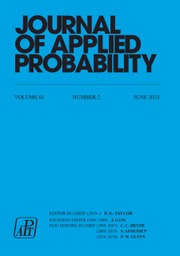Crossref Citations
This article has been cited by the following publications. This list is generated based on data provided by Crossref.
Crank, Keith N.
1988.
A method for approximating the probability functions of a Markov chain.
Journal of Applied Probability,
Vol. 25,
Issue. 04,
p.
808.
Requena, F.
1989.
Sobre una solucion recursiva para una cadena de Markov n-dimensional en tiempo continuo.
Trabajos de Estadistica,
Vol. 4,
Issue. 1,
p.
67.
Billard, L.
1990.
Discussion.
Statistics in Medicine,
Vol. 9,
Issue. 12,
p.
1433.
Ball, Frank
1990.
Stochastic Processes in Epidemic Theory.
Vol. 86,
Issue. ,
p.
71.
Sridhara, Rajeshwari
and
Watson, Ray
1990.
Stochastic three species systems.
Journal of Mathematical Biology,
Vol. 28,
Issue. 5,
p.
595.
Stadje, Wolfgang
1998.
Asymptotic probabilities in a sequential urn scheme related to the matchbox problem.
Advances in Applied Probability,
Vol. 30,
Issue. 03,
p.
831.
Crescenzo, Antonio Di
and
Martinucci, Barbara
2008.
A First-Passage-Time Problem for Symmetric and Similar Two-Dimensional Birth–Death Processes.
Stochastic Models,
Vol. 24,
Issue. 3,
p.
451.
Di Crescenzo, Antonio
and
Paraggio, Paola
2024.
Modeling the random spreading of fake news through a two‐dimensional time‐inhomogeneous birth‐death process.
Mathematical Methods in the Applied Sciences,
Vol. 47,
Issue. 18,
p.
13621.
Paraggio, Paola
and
Spina, Serena
2025.
Computer Aided Systems Theory – EUROCAST 2024.
Vol. 15174,
Issue. ,
p.
213.

